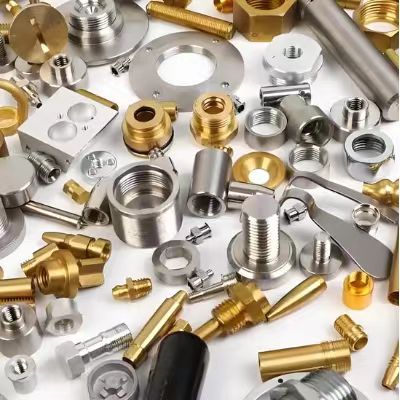Jun 07, 2025

Abstract:
The demand for non-standard custom fasteners is driven by increasingly complex engineering applications where off-the-shelf solutions are inadequate. This necessitates a rigorous design process tailored to unique functional, environmental, and integration requirements. This article outlines a systematic methodology for developing custom fasteners, focusing on the critical stages: requirement definition, conceptual design, detailed engineering analysis, prototyping, validation, and final specification. Crucially, it details the determination and justification of key technical parameters, including material selection (considering strength, corrosion resistance, temperature stability, weight), geometric specifications (thread form, head style, shank design, dimensional tolerances), mechanical properties (tensile/yield strength, shear strength, fatigue life, hardness), surface treatments and coatings (for corrosion protection, wear resistance, lubricity), and installation/removal torque specifications. Emphasis is placed on the interplay between parameters, performance trade-offs, manufacturability constraints, and cost optimization. Employing Finite Element Analysis (FEA), Computational Fluid Dynamics (CFD) for specific environments, material testing, and iterative prototyping is highlighted as essential for validating parameter choices and ensuring the fastener reliably meets its intended function within the broader assembly under real-world operating conditions. A structured approach ensures optimized performance, reliability, manufacturability, and cost-effectiveness for bespoke fastening solutions.
Keywords:
custom fastener design, non-standard fasteners, bespoke fasteners, fastener engineering parameters, technical fastener specifications, fastener material selection, fastener geometric design, fastener mechanical properties, fastener surface treatment, fastener prototyping and validation, Finite Element Analysis for fasteners, fastener torque specification, fastener manufacturing constraints, critical fastener parameters, specialized fastener development
The Design Process & Parameter Determination:
1. Requirement Definition & Analysis:
Application Context: Define the primary function (clamping, sealing, positioning, load-bearing type - tension, shear, combined), operating environment (temperature extremes, chemicals, humidity, pressure, vibration, exposure), expected service life, and criticality (safety implications).
Interface & Integration: Analyze mating components (materials, geometry, strength, surface finish), space constraints, accessibility for installation/removal, and assembly sequence.
Performance Criteria: Establish quantifiable targets for load capacity (static & dynamic), stiffness, fatigue life, corrosion resistance, electrical/thermal conductivity, weight limitations, and aesthetic requirements.
Regulatory & Standards: Identify any applicable industry standards (e.g., aerospace, automotive, medical), material certifications, or regulatory compliance needs.
2. Conceptual Design & Feasibility:
Generate initial fastener concepts (head type, drive type, thread type, shank configuration, locking features) based on requirements.
Conduct preliminary feasibility analysis considering potential materials, basic manufacturing routes (machining, forging, cold forming), and rough cost estimates.
Select the most promising concept(s) for detailed development.
3. Detailed Engineering Design & Parameter Determination:
Material Selection: Key Parameter Determination: Choose material(s) based on required Ultimate Tensile Strength (UTS), Yield Strength (YS), Shear Strength, Fatigue Strength, Corrosion Resistance (specific environment), Temperature Resistance, Density, Cost, and Manufacturability. Common choices include alloy steels (high strength), stainless steels (corrosion), titanium (strength/weight), nickel alloys (extreme temp/corrosion), aluminum (lightweight), plastics (electrical isolation), or composites.
Geometric Design: Key Parameter Determination: Precisely define Dimensions (major/minor diameter, length, head size), Thread Specifications (type - metric, unified, acme; pitch; class of fit; thread form optimization), Head Style & Drive Type (hex, socket, torx, custom), Shank Design (reduced shank, shoulder, tolerances - GD&T critical), fillet radii (stress concentration). Tolerances are paramount for fit and function.
Mechanical Properties: Key Parameter Determination: Specify minimum required UTS, YS, Shear Strength, Hardness (Rockwell, Vickers), and critically, Fatigue Strength (S-N curve determination often needed). Proof load requirements may be defined.
Surface Treatment & Coatings: Key Parameter Determination: Select treatments (Plating - zinc, cadmium, nickel; Conversion Coatings - phosphate, anodize; Organic Coatings - paint, powder coat; Dacromet/Geomet; Lubricity Coatings - PTFE, Moly) based on required Corrosion Protection Level (e.g., salt spray hours), Wear Resistance, Friction Coefficient, Galling Resistance, Aesthetics, Hydrogen Embrittlement Risk (post-plating baking), and compatibility with mating parts.
Torque & Preload: Key Parameter Determination: Calculate target Installation Torque and resulting Clamp Force (Preload) based on joint stiffness, friction coefficients (thread and under-head), and desired preload level (often 60-90% of proof load). Define Torque Tolerance ranges.
4. Analysis & Simulation:
Utilize Finite Element Analysis (FEA) to model stress/strain distribution, predict fatigue life, optimize geometry (stress concentrations), and verify load capacity under static and dynamic conditions.
Apply Computational Fluid Dynamics (CFD) if fluid flow or thermal effects are critical.
Perform analytical calculations for strength, buckling (slender fasteners), vibration loosening potential, and thermal expansion mismatches.
5. Prototyping & Validation:
Manufacture functional prototypes using representative processes.
Conduct rigorous testing: Dimensional Inspection, Mechanical Testing (tensile, shear, hardness), Fatigue Testing, Corrosion Testing (salt spray, humidity), Torque-Tension Testing, Vibration Testing (resistance to loosening), Environmental Testing (temperature cycling), and functional assembly tests.
Compare test results against the defined requirements and analytical predictions. Iterate design/parameters as necessary.
6. Final Specification & Documentation:
Create comprehensive technical drawings with all critical dimensions, tolerances (GD&T), material callouts, heat treatment specs, mechanical property requirements, surface finish, and coating specifications.
Define Quality Control (QC) procedures: inspection methods, sampling plans, and acceptance criteria for all key parameters.
Document the final design rationale, analysis results, and test validation data.
Conclusion:
Designing non-standard custom fasteners is a complex, iterative engineering process demanding close collaboration between design, materials, manufacturing, and quality teams. Success hinges on a deep understanding of the application requirements and the meticulous determination, analysis, and validation of interconnected key technical parameters. Balancing performance, reliability, manufacturability, and cost requires sophisticated tools like FEA and rigorous physical testing. A structured approach ensures the resulting bespoke fastener delivers optimal performance and longevity within its specific operational envelope.
Add: 2nd Floor, No. 979 Yunhan Road, Lingang New Area of China (Shanghai) Pilot Free Trade Zone, Shanghai
Tel: +86 18971319418
Mob: +86 15926422659
Email: [email protected]
Headquartered in Shanghai and strategically serving East China, Fasten Zone is a premier platform connecting global industries with rigorously vetted, high-quality fastener manufacturers. We combine deep technical expertise, an extensive certified supplier network, and competitive pricing to deliver exceptional value across standard and custom fastener requirements.